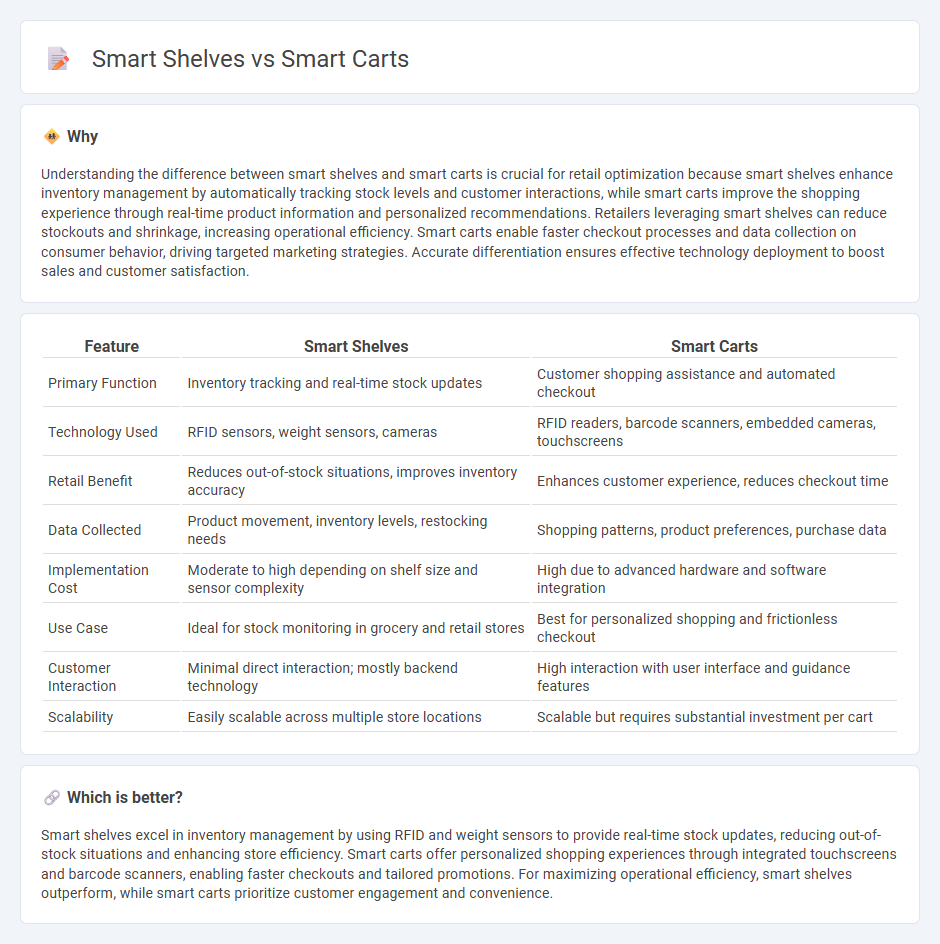
Smart shelves use IoT sensors and RFID technology to track inventory in real-time, enhancing stock management and reducing out-of-stock scenarios. Smart carts integrate barcode scanners and digital displays to streamline checkout processes and provide personalized shopping assistance. Explore how these innovations transform retail efficiency and customer experience.
Why it is important
Understanding the difference between smart shelves and smart carts is crucial for retail optimization because smart shelves enhance inventory management by automatically tracking stock levels and customer interactions, while smart carts improve the shopping experience through real-time product information and personalized recommendations. Retailers leveraging smart shelves can reduce stockouts and shrinkage, increasing operational efficiency. Smart carts enable faster checkout processes and data collection on consumer behavior, driving targeted marketing strategies. Accurate differentiation ensures effective technology deployment to boost sales and customer satisfaction.
Comparison Table
| Feature | Smart Shelves | Smart Carts |
|---|---|---|
| Primary Function | Inventory tracking and real-time stock updates | Customer shopping assistance and automated checkout |
| Technology Used | RFID sensors, weight sensors, cameras | RFID readers, barcode scanners, embedded cameras, touchscreens |
| Retail Benefit | Reduces out-of-stock situations, improves inventory accuracy | Enhances customer experience, reduces checkout time |
| Data Collected | Product movement, inventory levels, restocking needs | Shopping patterns, product preferences, purchase data |
| Implementation Cost | Moderate to high depending on shelf size and sensor complexity | High due to advanced hardware and software integration |
| Use Case | Ideal for stock monitoring in grocery and retail stores | Best for personalized shopping and frictionless checkout |
| Customer Interaction | Minimal direct interaction; mostly backend technology | High interaction with user interface and guidance features |
| Scalability | Easily scalable across multiple store locations | Scalable but requires substantial investment per cart |
Which is better?
Smart shelves excel in inventory management by using RFID and weight sensors to provide real-time stock updates, reducing out-of-stock situations and enhancing store efficiency. Smart carts offer personalized shopping experiences through integrated touchscreens and barcode scanners, enabling faster checkouts and tailored promotions. For maximizing operational efficiency, smart shelves outperform, while smart carts prioritize customer engagement and convenience.
Connection
Smart shelves use RFID and weight sensors to track inventory in real-time, while smart carts integrate with these shelves via IoT technology to provide seamless product recognition and personalized shopping experiences. This connectivity enables retailers to optimize stock management, offer instant price updates, and facilitate faster checkout processes. Together, they enhance operational efficiency and improve customer engagement in retail environments.
Key Terms
Real-time Inventory Tracking
Smart carts enhance real-time inventory tracking by automatically scanning products as customers shop, ensuring immediate stock updates and reducing out-of-stock scenarios. Smart shelves use weight sensors and RFID technology to monitor stock levels continuously, triggering instant alerts for restocking and minimizing inventory errors. Explore how combining smart carts and shelves can revolutionize retail inventory management and improve customer experience.
Personalized Shopping Experience
Smart carts utilize AI and customer data to provide tailored product recommendations and streamline checkout processes, enhancing in-store personalization. Smart shelves integrate RFID and sensors to monitor inventory in real-time and offer contextual promotions directly on displays, creating a dynamic shopping environment. Explore more about how these innovations transform personalized shopping experiences and boost retail efficiency.
Checkout Automation
Smart carts revolutionize checkout automation by using integrated sensors and RFID technology to scan items continuously as shoppers add products, eliminating the need for traditional checkout lines. Smart shelves complement this process by monitoring inventory in real-time and providing automatic alerts when stock runs low, enhancing overall store efficiency. Explore how combining smart carts and smart shelves can streamline retail operations and transform the shopping experience.
Source and External Links
How Smart Carts Are Revolutionizing Grocery Shopping - Smart carts enhance grocery shopping by using sensors and AI to track items automatically, enabling faster checkouts by allowing customers to pay directly on the cart and bypass long lines, also incorporating weight sensors for fresh produce which streamlines the process further.
Why Smart Carts Are the Winning Technology Format for Independent Grocers - Instacart's smart carts, known as Caper Carts, utilize computer vision and AI to identify items, help customers track totals in real-time, reduce checkout lines and congestion, ultimately improving the shopping experience and potentially increasing sales for independent grocers.
Grocery smart carts aim to be the saving grace for self-checkout hate - Caper smart carts increase basket sizes and require no infrastructure overhaul, with smart clip-on devices like those from Shopic offering cost-effective upgrades to traditional carts, providing flexibility for retailers and boosting shopper spend.
 dowidth.com
dowidth.com